 Key European projects such as the Vattenfall development off the Norfolk coast have stalled due to rising costs. Photo: Vattenfall
Key European projects such as the Vattenfall development off the Norfolk coast have stalled due to rising costs. Photo: Vattenfall
Europe has lost its crown to China as the world's largest builder of offshore wind power as UK developers grapple with rising costs and stagnating electricity prices.
According to the Global Wind Energy Council (GWEC), the global offshore wind market was 64.3 gigawatts of electricity last year, with China accounting for about 49% of that amount compared to Europe's 47%.
Large wind power producers “had experienced a profitability crunch over the past few years, forcing them to cut costs and selectively withdraw from smaller or slow-growing markets,” the report says.
In its annual global offshore wind report, GWEC stated that by the mid-2020s, “bottlenecks in the supply chain could occur in all regions of the world except China.”
Rebecca Williams, Head of Global Offshore Wind Power at GWEC, said: «It will require immediate investment and global collaboration to address these bottlenecks.»
In Europe, installation levels last year were the lowest since 2016. Europe's total offshore wind capacity reached 30 GW last year, 46% of which is in the UK.
While the UK continues to dominate European offshore wind power, Britain's ambitions to become a clean wind energy exporter are in danger of being thwarted. as the rest of Europe catches up.
1808 Fall of domestic power
Rising supply chain costs pushed up the price of wind turbines, and rising global interest rates substantially increased refinancing costs.
In July, the Swedish energy giant Vattenfall suspended the construction of a large 1.4 gigawatt wind farm. off the coast of Norfolk after soaring inflation rendered the project unviable.Wind farms in the UK are primarily governed by contracts for difference (CfD), which are 15-year subsidy agreements between the government and generators designed to guarantee stable revenues for the power schemes.
In the UK, in the middle of another round of contract bidding. In the current distribution round, which closes next month, offshore wind is competing with solar and onshore wind, which are cheaper to build.
Boris Johnson has set his sights on turning Britain into a «Saudi wind Arabia». while he was prime minister in 2020 and the UK has set a target of 50 GW of offshore wind power by 2030, up from the current around 14 GW.
However, a GWEC report showed that the UK's share of new offshore wind projects is forecast to fall from nearly half today to about a fifth in a decade as Germany, Denmark, the Netherlands and France speed up building their own wind farms. /p>
The lobby group warned that investors interested in meeting their environmental goals need wind farm projects with permits and predictable returns from willing clients.
Ms Williams added: wind farms have been delayed or stalled indefinitely due to inadequate and ineffective permitting and licensing regulations. These factors have created uncertainty and forced developers to reconsider the viability of their projects, and in some cases even stop development.
“Such an inefficient policy based on downward price competition and, combined with impractical and unattainable local content conditions, will increase the cost of the project and slow down the pace of offshore wind energy deployment needed to bring the world to a clean zero level. '.





















































Свежие комментарии